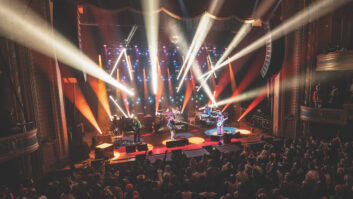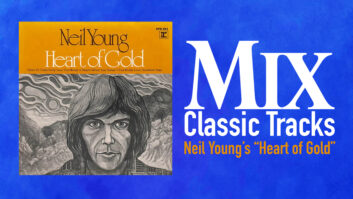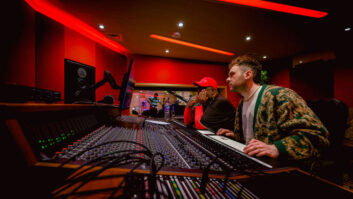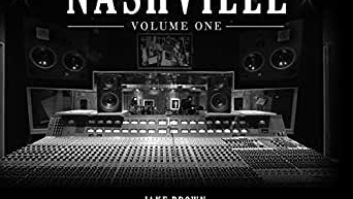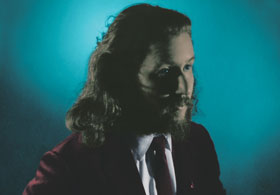
Photo: Neil Krug
When we last checked in with Jim James, the charismatic and visionary frontman of the eclectic rock/soul/neo-psychedelic band My Morning Jacket, they had recorded a stunning album with co-producer/engineer Tucker Martine, called Circuital, essentially live in the studio, which in that case was actually an echo-y church school gymnasium in the band’s hometown of Louisville. That came out May 2011 and since then they’ve been touring almost nonstop all over the U.S., Europe, Canada, Mexico, Australia and Japan, bringing their mesmerizing, ever-changing live show to a multitude of festivals and headlining dates in large and small venues.
Somehow, in the midst of what must seem like a never-ending tour, James carved out short periods at home to complete his first full-length solo album, Regions of Light and Sound of God, just out on the ATO label. Call him eccentric, idiosyncratic, unique, whatever—if you’re at all familiar with his work, you just knew he would come up with something strange, beautiful and compelling on his own outside of MMJ, and that’s precisely what he did on Regions.
It’s definitely not a band album: James played most of the instruments himself and it’s chock-full of loops, samples, unusually layered instruments and vocals, and many interesting sonic touches. It’s all over the place stylistically, with nods to classic late ’60s/early ’70s soul and funk, a dash of doo-wop and more dreamy and poetic musical spaces. There are more keyboards than guitars (MMJ is quite guitar-oriented), with haunting piano on a couple of tracks, some Pink Floydian synths here, and some obviously Stevie Wonder-inspired synths there. James’ characteristic deeply reverb’d lead vocals are much in evidence, and throughout there are distorted bass and drum parts that contrast effectively with cleaner lines and smooth-as-silk strings that recall predecessors such as Curtis Mayfield and Marvin Gaye.
“I consider Curtis Mayfield to be the Buddha; I look up to him so much,” James says. “His music is so important to all living beings, like water or air. Marvin was a darker force than Curtis, but I consider What’s Goin’ On to be perhaps the greatest album ever made. It speaks to every vein of the human experience, musically and otherwise.”
James is no newcomer to home recording. “I’ve been doing it since high school,” he states. “I started on a boombox, then got a 4-track, then started working with my cousin John and his 8-track reel-to-reel. We recorded a few things on ADAT early on, which was just a horrible medium, and we used to mix things to DAT—God, remember DAT? Now I own a Studer A827 with Pro Tools, etc., but with a good setup and good converters, I think digital sounds great. I have a Burl B2 Bomber [A-to-D converter] and the Apogee Symphony converters we used to mix the record.”

James engineered the album himself, working “in little chunks, a week here or there, over the course of two years” in his studio, which was set up with considerable help from Tucker Martine and Louisville engineer Kevin Ratterman (who mixed the album with main mixer Rick Kwan and James at Ratterman’s Funeral Home Studio). Ratterman says James’ studio is “super-sweet. It’s in this ranch-style home, in the front living room. It’s a decent amount of space and it’s got a window that looks out over a park—really nice. He’s got a Trident 80B [console], ProAc [100] monitors, and a bunch of Telefunken pre’s—V76s and V72s. He also has an RCA preamp, maybe from the late ’50s or early ’60s, they used specifically to amplify ribbon mics. Jim’s in love with old RCA mics.” Indeed, James notes, “I alternated between using an RCA 44, a 77 and a [Neumann] M49 for vocals.” Most of the deep reverb on the vocals came from an old EMT 140 plate James adores.
“Where on Circuital we were really focusing on getting the entire take—including the main vocal—live, I obviously can’t do that by myself in a studio,” James notes. “So Regions used more of a building-block kind of method. Some songs, like ‘A New Life’ and ‘State of the Art’ are full takes, and then some, like ‘All Is Forgiven,’ or ‘Know Til Now’ are comped. Most started as a vocal and rhythm bed and then stuff comes in. But most of these had all the elements in place in my mind before I started cutting them. So I’d create the beat, then maybe put on a bass or Wurlitzer, then the vocal, then add more and more ’til it was done.”
As for the mix, which was done on the Funeral Home’s late ’70s Trident TSM, Ratterman notes, “Jim had everything super-organized. It was almost like opening up a final mix. There was lots of creative editing and there were already effects printed and EQs. He almost could have released it the way he mixed it. With our engineer ears, Rick and I sort of tailored it a bit, cleaned up a few frequency things, made it a little bigger in places. But overall it still feels kind of surreal, which is what Jim was looking for.”
Jim James: “I wanted the record to sound like it was the past of the future. Like you were living in the year 4030, but hearing a record that was made in 3970, if that makes sense.”
